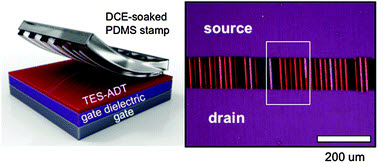
연구
Research Outcome
미래를 창조하는 포스텍 화학공학과
Unified film patterning and annealing of an organic semiconductor with micro-grooved wet stamps
- Title of paper
- Unified film patterning and annealing of an organic semiconductor with micro-grooved wet stamps
- Author
- [박찬언교수 연구실]
- Publication in journal
- Journal of Materials Chemistry C 4(29), p6996-7003 (August 2016)
- Publication date
- 20160807
[Abstract]
A unified patterning and annealing approach was successfully demonstrated for 5,11-bis(triethylsilylethynyl)-anthradithiophene (TES-ADT) films spun-cast on polymer-treated SiO2 dielectrics. First, rubbery polydimethylsiloxane (μ-PDMS) stamps with microscale periodic grooves were swollen in 1,2-dichloroethane and then softly placed onto amorphous-like TES-ADT films. In this case, the film sides physically in contact with the wet stamps were quickly absorbed into the PDMS matrix while the non-contact area formed highly-ordered phases by the solvent-annealing effect. The resulting patterns of TES-ADT contained discernable crystallites, where the grain sizes drastically decreased and their shapes transformed from spherulites to optically featureless ones with a decreasing line width from 100 to 2.5 μm. Unlike ordinary systems containing spherulitic domains, the 2.5 μm line-confined TES-ADT patterns contained layer-stacked crystallites but an optically invisible grain boundary, yielding an unexpectedly high field-effect mobility of 2.60 cm2 V−1 s−1 in organic field-effect transistors (OFETs), with narrow deviations less than 8% (averaged from 42 devices). The results suggest that the well π-overlapped grains and their smooth connections are key factors to achieve high performance multi-array OFET applications.
A unified patterning and annealing approach was successfully demonstrated for 5,11-bis(triethylsilylethynyl)-anthradithiophene (TES-ADT) films spun-cast on polymer-treated SiO2 dielectrics. First, rubbery polydimethylsiloxane (μ-PDMS) stamps with microscale periodic grooves were swollen in 1,2-dichloroethane and then softly placed onto amorphous-like TES-ADT films. In this case, the film sides physically in contact with the wet stamps were quickly absorbed into the PDMS matrix while the non-contact area formed highly-ordered phases by the solvent-annealing effect. The resulting patterns of TES-ADT contained discernable crystallites, where the grain sizes drastically decreased and their shapes transformed from spherulites to optically featureless ones with a decreasing line width from 100 to 2.5 μm. Unlike ordinary systems containing spherulitic domains, the 2.5 μm line-confined TES-ADT patterns contained layer-stacked crystallites but an optically invisible grain boundary, yielding an unexpectedly high field-effect mobility of 2.60 cm2 V−1 s−1 in organic field-effect transistors (OFETs), with narrow deviations less than 8% (averaged from 42 devices). The results suggest that the well π-overlapped grains and their smooth connections are key factors to achieve high performance multi-array OFET applications.
DOI:10.1039/C6TC01723A




